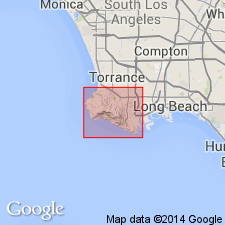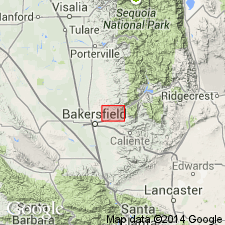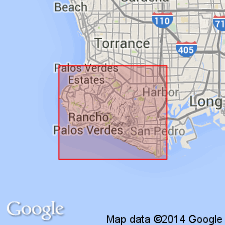
- Usage in publication:
-
- Altamira shale member*
- Modifications:
-
- Original reference
- Biostratigraphic dating
- Dominant lithology:
-
- Shale
- Tuff
- AAPG geologic province:
-
- Los Angeles basin
Summary:
Pg. 131+. Altamira shale member of Monterey shale. Basal member of Monterey shale in Palos Verdes Hills. Lower 280 feet are chiefly silty shale, including Portuguese tuff bed at top. Middle part, 400 to 675 feet thick, is chiefly porcelaneous and cherty shale, the basal 2 to 6 feet of which is here named Miraleste tuff bed (pumice lapillae). Upper 150 +/-feet chiefly phosphatic and bituminous shale. Rests on Miocene basalt and on Franciscan(?) formation. Underlies Valmonte diatomite member of Monterey shale. Fossils (Foraminifera, mollusks) [listed]. Age is late and middle Miocene, based on Foraminifera assemblages.
Type region: on south slope of hills along and adjoining Altamira Canyon, Palos Verdes Hills, [San Pedro 7.5-min quadrangle, Los Angeles Co.], southern CA. [Named from Altamira Canyon.]
Source: Publication; US geologic names lexicon (USGS Bull. 896, p. 40); GNU records (USGS DDS-6; Menlo GNULEX).

- Usage in publication:
-
- Altamira shale member*
- Modifications:
-
- Areal extent
- Biostratigraphic dating
- AAPG geologic province:
-
- Los Angeles basin
Summary:
Pg. 16-33, 39-40, pls. 3, 4, 6-7, 10B, 28. Altamira shale member of Monterey formation. Basal member of Monterey in Palos Verdes Hills area, Los Angeles County, southern California. Includes thick bentonite tuff, Portuguese tuff bed, and a thin pumice tuff, Miraleste tuff bed. Thickness about 1,000 feet in type region, on southern slope of hills adjoining Altamira Canyon; about 600 feet on north slope of hills owing to overlap on schist basement. Underlies Valmonte diatomite member of Monterey. Foraminifera identified from lower, middle, and upper parts of Altamira indicate middle and late Miocene ages; SIPHOGENERINA BRANNERI to BULIMINA UVIGERINAFORMIS zones. Division between middle and upper Miocene is between middle and upper parts of Altamira. [Altamira shown on geologic map of Palos Verdes Hills (pl. 1) as middle Miocene age.]
Measured sections described: lower part of Altamira in canyon east of Portuguese Canyon; middle part in sea cliff between Malaga Canyon and Flatrock Point, in east fork of Altamira Canyon, and in Agua Negra Canyon; and upper part in sea cliff southwest of mouth of Malaga Canyon, in Agua Amarga Canyon, and in sea cliff on southern side of Palos Verdes Point.
Source: Publication; US geologic names lexicon (USGS Bull. 1200, p. 66); GNU records (USGS DDS-6; Menlo GNULEX).

- Usage in publication:
-
- Altamira Shale Member*
- Modifications:
-
- Biostratigraphic dating
- AAPG geologic province:
-
- Los Angeles basin
Summary:
Pg. 87. "MITRELLA ALTA ... has been doubtfully identified from a middle Miocene assemblage from the Altamira Shale Member of the Monterey Shale of the Los Angeles basin (Woodring and others, 1946)."
Source: Publication; GNU records (USGS DDS-6; Menlo GNULEX).

- Usage in publication:
-
- Altamira Shale Member*
- Modifications:
-
- Geochronologic dating
- AAPG geologic province:
-
- Los Angeles basin
Summary:
Portuguese Tuff Bed in Altamira Shale Member of Monterey Formation dated by Turner (1970) at 14.9 +/-Ma is close to Relizian-Luisian boundary. [All K-Ar ages have been calculated using decay constants recommended by the IUGS Subcommission on Geochronology (Steiger and Jager, 1977, Earth and Planetary Science Letters, v. 36, p. 359-362).]
Source: GNU records (USGS DDS-6; Menlo GNULEX).

- Usage in publication:
-
- Altamira Shale Member*
- Modifications:
-
- Age modified
- AAPG geologic province:
-
- Los Angeles basin
Summary:
Age is early(?) and middle Miocene in Palos Verdes Hills based on diatoms. Diatoms range from Subzones a and b of D. LANTA Zone to Subzone a and b of D. HUSTEDTU-D. LANTA Zone (middle Miocene). But fig. 4 shows that unit may be as old as latest early Miocene.
Source: GNU records (USGS DDS-6; Menlo GNULEX).
For more information, please contact Nancy Stamm, Geologic Names Committee Secretary.
Asterisk (*) indicates published by U.S. Geological Survey authors.
"No current usage" (†) implies that a name has been abandoned or has fallen into disuse. Former usage and, if known, replacement name given in parentheses ( ).
Slash (/) indicates name conflicts with nomenclatural guidelines (CSN, 1933; ACSN, 1961, 1970; NACSN, 1983, 2005, 2021). May be explained within brackets ([ ]).

